How to Get from Italy to Croatia (and Vice Versa)
 Many years ago, during a trip through Germany with the husband, we saw a television ad on CNN International that stopped us in our tracks. The vacation destinations advertised on that station were quite different than the ones we saw marketed to US audiences back home, so it wasn’t until that moment that we’d seen images of (and decided we must visit) Croatia. The pictures were stunning, and as it happened we’d met a guy in Berlin who had grown up in Croatia, so we immediately bombarded him with questions.
Many years ago, during a trip through Germany with the husband, we saw a television ad on CNN International that stopped us in our tracks. The vacation destinations advertised on that station were quite different than the ones we saw marketed to US audiences back home, so it wasn’t until that moment that we’d seen images of (and decided we must visit) Croatia. The pictures were stunning, and as it happened we’d met a guy in Berlin who had grown up in Croatia, so we immediately bombarded him with questions.
The following year, after a visit to northern Italy, we spent five days in an apartment near Split, in a building owned by our Berlin friend’s best friend. It was absolutely beautiful, and although I haven’t yet made it back to Croatia I can totally understand why people want to go. Which is why I’m happy to help you figure out how to get from Italy to Croatia in this article. (Of course, I assume that you’ll come back to Italy again at some point in the future, right? Right?)
Italy and Croatia are separated by the Adriatic Sea, and because so much of Croatia is coastal you won’t be surprised to learn that there are lots of ferries shuttling back and forth between Italian and Croatian ports every day. The ferry may not always be the best option for you, but it’s a more realistic choice than the ferries from Italy to Greece tend to be, because Croatia is much closer to Italy.
Normally, I have a top recommendation in these transportation articles, where I tell you which way I’d say is the best to get from Point A to Point B. This time, it’s a little more complicated. There are a few really good choices below, so you’ll need to figure out which one works best for you and the trip you’ve got planned.
One more note about all that Croatian coastline, and then I’ll get to the how-to stuff on getting from Italy to Croatia, I promise.
During my trip to Croatia, the husband and I ended up grabbing the only two remaining seats on a boat ride on a lake in one of the national parks. The rest of the boat was taken up by a German tour group and their Croatian guide. The guide was fluent in German, obviously, but it had been so long since she’d had an opportunity to practice her English that the three of us chatted happily for the entire boat ride.
I remember her telling us that more and more Italians were coming to Croatia on holiday instead of spending time on their own Italian beaches. When we asked her why she thought that was, she said, “It’s the water – Italians don’t want to swim in the Adriatic on their side anymore, it’s too dirty. They come over here to swim now.” Anyone who’s tried to find a cheap hotel room in Italy or a spot on a beach in Italy during August may argue with that statement, as Italian beaches remain crowded in summer – but I can’t disagree with her on one count: the water in Croatia is gorgeous.
Getting from Italy to Croatia by Ferry
 If your Italian adventure will be ending in or near a city on the eastern coast of the country, then taking a ferry to Croatia from Italy may be the way to go. The departure points from Italy are Venice, Ancona, Pescara, and Bari, and from each port you’ve got at least a couple of choices as far as destinations in Croatia and ferry lines goes.
If your Italian adventure will be ending in or near a city on the eastern coast of the country, then taking a ferry to Croatia from Italy may be the way to go. The departure points from Italy are Venice, Ancona, Pescara, and Bari, and from each port you’ve got at least a couple of choices as far as destinations in Croatia and ferry lines goes.
Keep in mind when you’re planning your trip that the frequency of the Italy-Croatia ferries varies depending on the season. During the summer, there are far more crossings each day than there are during the spring and fall, and not all ferries run year-round, either. In other words, it’s important to find out the exact schedules for when you’ll be there before you decide the ferry is your best choice.
Here is an overview of the various ferry routes for the Italy-Croatia crossings, listed by Italian departure city and with the ferry company names in parentheses after each destination city.
- Ferries from Venice to Croatia:
>> to Mali Losinj, Piran, Pula, Rovinj, Porec, Rabac (Venezia Lines – these are passenger ferries only, no cars) - Ferries from Ancona to Croatia:
>> to Zadar, Split (Jadrolinija Ferries)
>> to Split, Vis, Stari Grad/Hvar Island (Blue Line Ferries)
>> to Split (SNAV Ferries) - Ferries from Pescara to Croatia:
>> to Split, Stari Grad/Hvar Island (SNAV Ferries or Jadrolinija Ferries) - Ferries from Bari to Croatia:
>> to Dubrovnik (Jadrolinija Ferries)
Look at a map of the departure and arrival ports listed above and you’ll understand why things like travel time and ticket prices will vary depending on where you’re leaving Italy, where you’re going in Croatia, and also when you’re making the trip. So you’ll need to look up all your options before deciding which one suits your travel budget and style best – but here are some reference points to get you started.
- A one-way ticket from Venice to Rovinj on Venezia Lines ranges from €48 in the low season to €53 in the high season (and that’s not including taxes, fees & surcharges).
- A deck-only one-way ticket from Ancona to Split or Bari to Dubrovnik on Jadrolinija Ferries ranges from €40 in the low season to €48 in the high season and €55 on a summer weekend. You can pay as much as €173 for a deluxe 2-berth cabin on that same trip on a summer weekend, and there are lots of options between those two extremes.
- A one-way ticket from Pescara to Hvar Island or Split on SNAV Ferries runs from €50-95 depending on the season and what promotions are going on.
- A one-way ticket from Ancona to Split or Hvar Island on Blue Line Ferries can be €40-48 for a deck ticket, all the way up to €116-136 for a “VIP Cabin” (with lots of options in between), and this doesn’t include any charge for a vehicle or the summer weekend rate increase.
- The trip from Venice-Rovinj takes about 2.5 hours if you get a direct boat.
- The trip from Ancona-Split takes about 9 hours.
- The trip from Bari-Dubrovnik takes about 8-9 hours.
- The trip from Pescara-Hvar Island takes about 4.25 hours.
For more information about all your options, your best bet is to check with the individual ferry companies. There are sites which claim to have the information for all the different companies, but in my searches I found some were outdated and others incomplete. If there’s one that’s always up-to-date and thorough, please let me know – but in the meantime (and even if there is) it’s probably best to check each ferry company’s website. Here are the sites for Jadrolinija Ferries, Blue Line Ferries, Venezia Lines, and SNAV Ferries. Be warned, not all of those sites are created equally when it comes to ease of use. Be patient…
(Note that with the exception of the catamaran service from Venice to Croatia, the rest of the ferries you can take from Italy to Croatia are car ferries that also have passenger service. If you’re leaving from Venice, there’s no car ferry to Croatia.)
Flying from Italy to Croatia
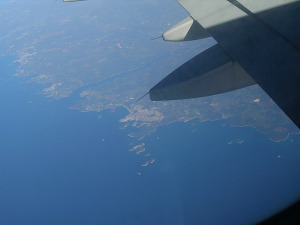 When I first started researching the article about how to get from Italy to Greece, I assumed that the ferries would be the cheapest option – or at least be competitively priced with the airlines. But what I found is that the all the budget airlines that have sprung up in the last decade or so have really made flying relatively short distances within Europe much more cost-effective, and sometimes significantly cheaper than any other method of transportation.
When I first started researching the article about how to get from Italy to Greece, I assumed that the ferries would be the cheapest option – or at least be competitively priced with the airlines. But what I found is that the all the budget airlines that have sprung up in the last decade or so have really made flying relatively short distances within Europe much more cost-effective, and sometimes significantly cheaper than any other method of transportation.
With the routes between Italy and Croatia, this is true to a certain extent – although because the distance from Italy to Croatia by boat is much shorter, the ferries are still worth considering from a budget standpoint, especially if you’re already on one of the eastern coastal cities of Italy where the ferries leave from. If your last stop in Italy is one of the cities from which a budget flight leaves, on the other hand, then flying may be your best option budget-wise. It’s almost always going to be your best option time-wise, since many of the ferries take 8+ hours.
The budget airlines I’ve found with routes connecting Italy and Croatia are:
- easyJet – Milan to Dubrovnik, Milan to Split
- Germanwings – Milan to Zagreb, Bologna to Zagreb
- Ryanair – Pisa to Zadar
With a budget airline you can sometimes find one-way promotional fares for ridiculously low prices, even under €10. These fares are rarely as cheap as advertised, since the airlines then end up charging you for every little thing you thought was “free” on airlines, but it’s always worth looking – as long as you read the fine print.
A quick scan of some of the round-trip tickets from Italy to Croatia at the time of this writing revealed a €11 fare to Zadar on Ryanair, a couple of €41 fares to Split and Dubrovnik on easyJet, and one that came in over €170 into Zagreb on Croatia Airlines. All of those options should be considered in the “extremely cheap” range, because you’ll also find fares in the €300-400 range as well for a flight from Milan to Dubrovnik or Rome to Split.
As far as schedules go, remember that even though you’ll be seeing a flight that lasts less than two hours between Italy and Croatia, because it’s international travel (Croatia’s not yet part of the EU) you’ll need to factor in extra time spent at the airport and getting to and from the airport, as well. Be sure to weigh all that when you’re thinking about how much time a flight could potentially save over a ferry.
Flights to Zagreb:
Flights to Split:
Flights to Dubrovnik:
Flights to Zadar:
Getting from Italy to Croatia by Train
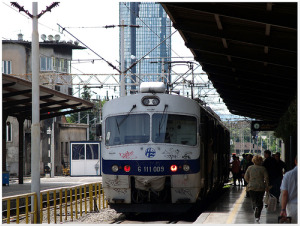 Unlike some countries in Europe, Croatia isn’t ideally suited to train travel. (And this is a train junkie saying this, so you can trust me.) Much of the fabled Croatian coast isn’t even accessible via train, so even if you use a train to get into the country itself you’ll need to move to a different mode of transport once you arrive.
Unlike some countries in Europe, Croatia isn’t ideally suited to train travel. (And this is a train junkie saying this, so you can trust me.) Much of the fabled Croatian coast isn’t even accessible via train, so even if you use a train to get into the country itself you’ll need to move to a different mode of transport once you arrive.
The main cities which are reachable by train in Croatia are Zagreb, Pula, Rijeka, and Split (although you’ll have to go through Zagreb to get to Split anyway). This isn’t a short journey from any point in Italy, and it can be especially long if you’re starting from points further away from Croatia than Venice, so keep that in mind when you’re planning.
For reference, here’s some information about train travel from Italy to Croatia:
- Venice to Zagreb can take from 7.5-10 hours and can require 1-2 train changes along the way.
- Venice to Split can take from 15-20 hours and require as many as 3 train changes.
- Rome to Zagreb can take from 11.5-15.5 hours and require 1-2 train changes.
- Milan to Zagreb can take from 10-12 hours and require 1-2 train changes.
- A one-way ticket from Venice to Zagreb on the train can cost roughly $40-110 for a 2nd class ticket or $120-195 for a 1st class ticket (for direct trains that’s for either a couchette or a sleeper cabin, and including reservations where required).
Getting from Italy to Croatia by Bus
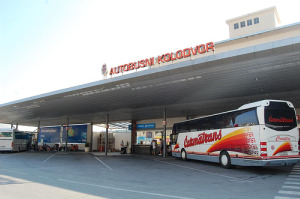 As mentioned, once you get into Croatia – however you get there – if you’re looking to move around the country your best options are to get around by bus or by car (or by boat, if you’re strictly speaking about coastal towns). So it stands to reason that one of the ways you can get to Croatia from Italy in the first place is by bus.
As mentioned, once you get into Croatia – however you get there – if you’re looking to move around the country your best options are to get around by bus or by car (or by boat, if you’re strictly speaking about coastal towns). So it stands to reason that one of the ways you can get to Croatia from Italy in the first place is by bus.
The popular Eurolines bus company runs regular trips from Venice to several points in Croatia, including Pazin, Pula, and Medulin. Eurolines is the biggest European bus company, and the one most people use to get from one country to another within Europe. With Eurolines, there’s one daily bus that leaves Venice for Croatia – it departs at 10:45 and arrives at its last point in Croatia (Medulin) at 17:35. A ticket on Eurolines from Venice to Pula is roughly €24 one-way, or €48 round-trip. From Venice to Medulin is €26 one-way, or €52 round-trip.
I also found an Italian bus company called SAF that’s based in Udine in the northeast of Italy, so they’ve got some international bus services to Croatia (among other countries). SAF buses run from Trieste to Rijeka, Split, Medugorje, Dubrovnik, Pula, Rovinj, Medulin, Zagreb, and several other Croatian cities. Some sample travel times are: 2.5 hours to Rijeka, 10.5 hours to Split, 15 hours to Dubrovnik, 3 hours to Pula, and 5 hours to Zagreb. What the SAF site (and the Trieste bus station site, where SAF sends you) lacks is pricing information for its routes.
In addition to these two reliable bus companies, I found a couple of others for which I have only partial information. I found one reference to a bus company called “EuroTourist,” but I can’t for the life of me find any information about them online to indicate (a) that they still exist and (b) what their routes and ticket prices are – so if you know anything about this company, please let me know! I also found a company called Croatia Bus that runs a route between Trieste and Zagreb (buses leave Trieste at 17:00 and arrive in Zagreb at 21:15), but it looks like that company is more of a coach-for-hire service than one where you can buy individual tickets. (Again, it’s unclear, so if you’ve got information about this company please let me know.)
All of this might be a little confusing, so here’s what I’d suggest is the important thing to remember: if you’re in Venice or Trieste and you want to get to Croatia, a Eurolines or SAF bus can be a cheap and relatively quick way of doing that. If you’re not already in Venice or Trieste, you might want to consider other options (or re-structure your trip to end your Italy stay in Venice or Trieste so it’s an easier launch-pad for Croatia).
Driving from Italy to Croatia
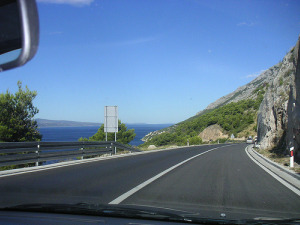 When you read that getting around Croatia by train is challenging, you might think the roads are just as bad – but they’re not. In fact, several years ago Croatia made a huge investment in infrastructure and now there are fantastic-to-drive-on highways connecting several major cities. When I visited many years ago, the highway only went as far as Split – but it’s in the process of being extended to Dubrovnik. You’ll also find the motorways connecting Zagreb with Rijeka and Split to be fantastic.
When you read that getting around Croatia by train is challenging, you might think the roads are just as bad – but they’re not. In fact, several years ago Croatia made a huge investment in infrastructure and now there are fantastic-to-drive-on highways connecting several major cities. When I visited many years ago, the highway only went as far as Split – but it’s in the process of being extended to Dubrovnik. You’ll also find the motorways connecting Zagreb with Rijeka and Split to be fantastic.
According to my route-planning website of choice, Via Michelin, driving from Venice to Split is a journey of about 7.5 hours and will cost you over €100 in gas, road taxes, and tolls. Venice to Rijeka is a relatively short 3.5 hour trip that will cost around €45 (gas, road taxes, and tolls again). Venice to Zagreb is a little less than 5 hours, and all the costs add up to around €60. And Venice to Dubrovnik is a 10.5 hour trip that will run around €130 total (it’s longer than you might think because, for the time being, that fabulous motorway doesn’t yet extend all the way to Dubrovnik – when it does, you can expect travel times to decrease).
And yes, when you get off the highway you’ll likely be immediately faced with tiny, narrow, winding roads that may have stunning views overlooking the water – but may make the going quite slow. Hopefully you can sit back and enjoy the view.
And now that you’re in Croatia…
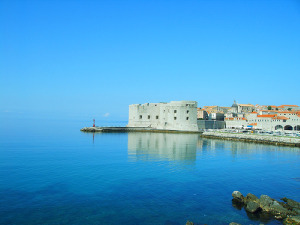
- BootsnAll has a Croatia travel guide you might find useful, called WhyGo Croatia.
- You’ll find all kinds of accommodation options in Croatia, including hotels in Croatia, hostels in Croatia, and resorts in Croatia (if you’ve got the budget for them!).
- There are plenty of things to do in Croatia, from sailing and diving to checking out the beautiful national parks.
photos, top to bottom, by: jimmyharris, lostajy, bortescristian, Goran Zec, kawanet, vacation2, jonsson